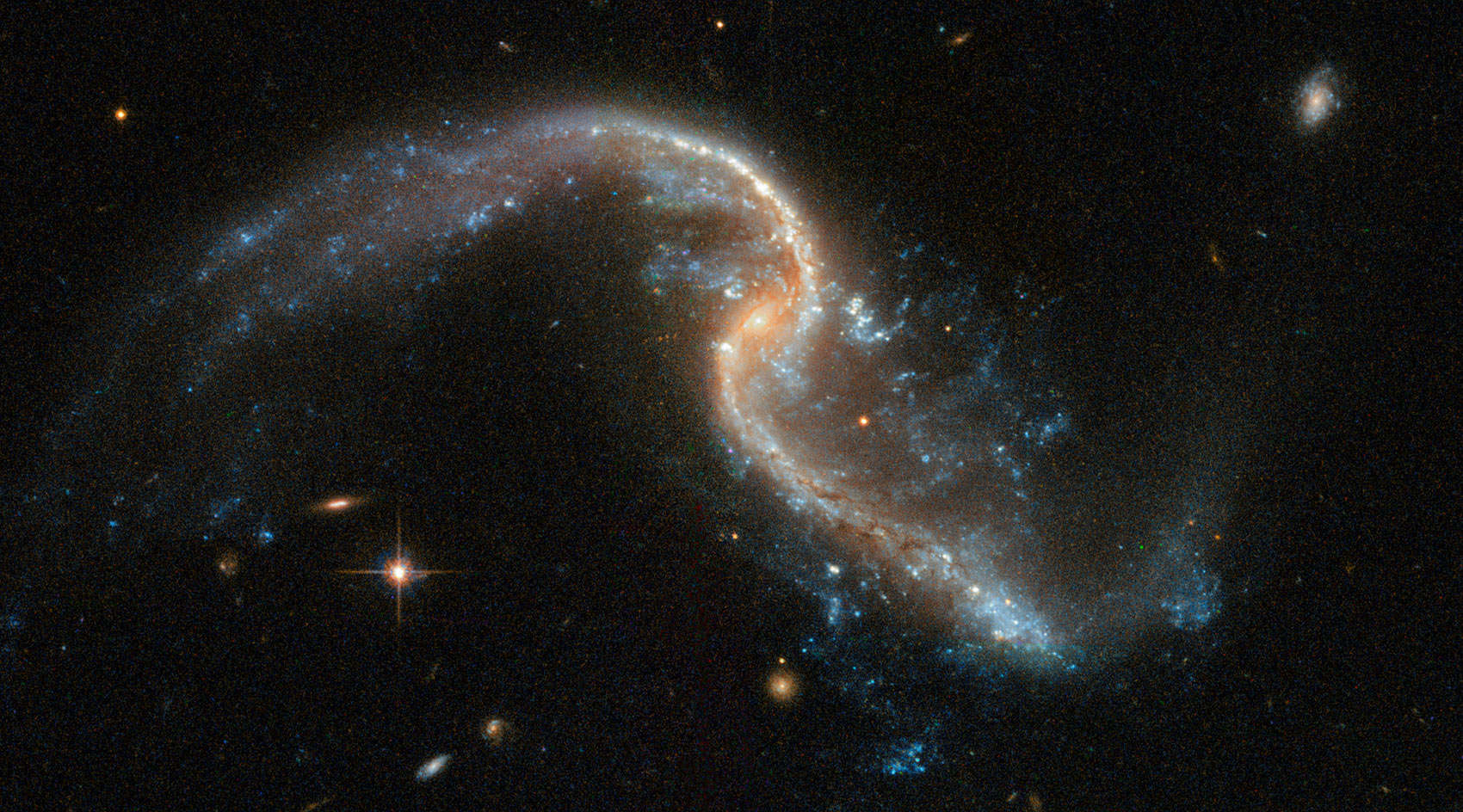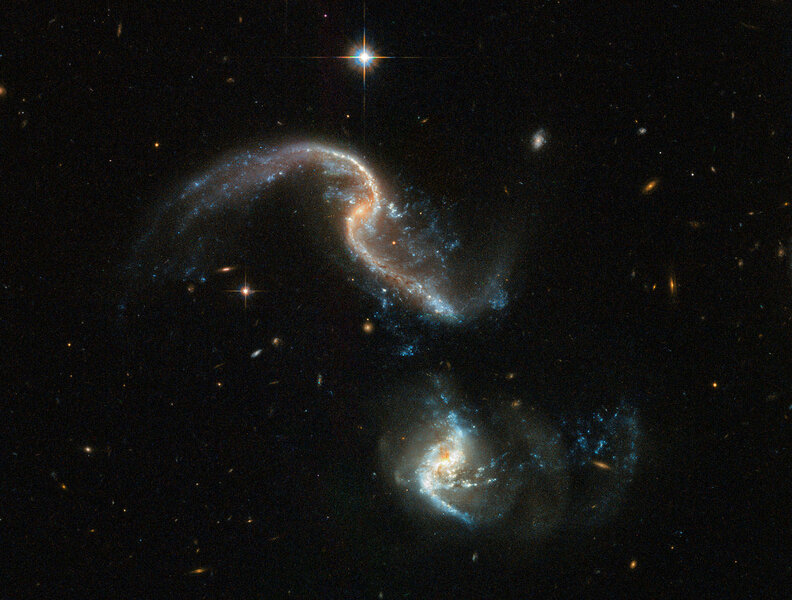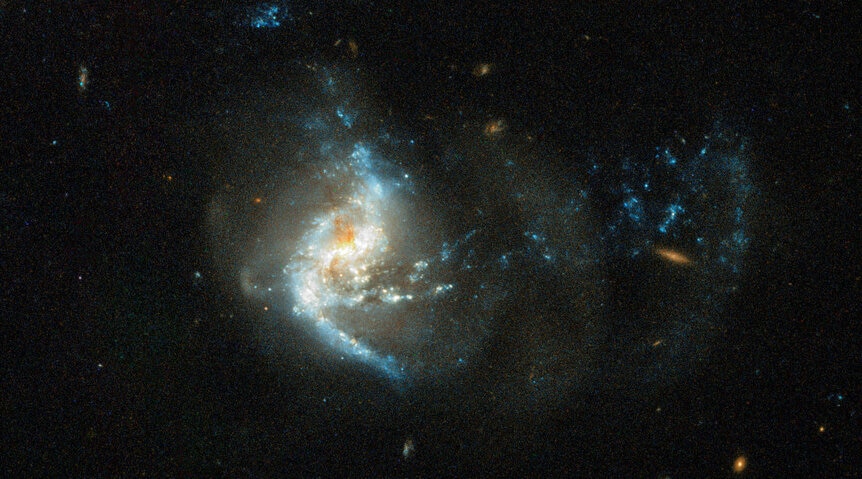Create a free profile to get unlimited access to exclusive videos, sweepstakes, and more!
When two galaxies love each other very much…

Have you ever seen two galaxies in love?
Oh, at first there's the flirting from a distance, but then as they get closer the attraction gets stronger. They feel themselves drawn to each other, each with their arms extended toward the other. If circumstances aren't right they may pass each other, circling around in a lovers' dance, but the inevitably of their fate is to be together. Finally, slowly, they touch, wrap themselves around each other, and then, in the end, merge into one. The result: Fecundity, as stars are born by the millions.
It's a tale as old as the cosmos. And it's illustrated beautifully by the two galaxies that make up Arp 256:
These two galaxies (typically called Arp 256N for the northern one and Arp 256S for the southern one) are a bit less than 400 million light years from Earth and are pretty similar, both spirals of roughly the same size. They don't appear to be part of a larger cluster; a wider field of view than this Hubble image shows a couple of smaller galaxies nearby but that's about it. Yet, somehow, they found each other.
The galaxies are colliding. Their travels through space brought them together, and most of the indications are this is the early stage of the collision (their centers are at least 100,000 light years apart, so decently far). The north galaxy has beautifully extended tidal tails: Long streams of gas and stars drawn out by the gravity of the other galaxy. They're either approaching their first close pass or are now drawing apart after the first encounter, given the shape and structure of the tails. The southern galaxy is disturbed as well, with what tails of gas and stars off to the right.
Wherever you see blue is where stars are forming. The gravitational disturbance during a collision is strong, and can send gas clouds slamming into each other, which can boost star formation. This makes lots of stars, some of which are young, massive, blue, and very luminous. They don't live long, so these show you where stars are actively being born. Some researchers looked at star clusters in the northern galaxy and found them to be around 10 million years old, which means they likely formed when the collision was well underway.
Speaking of which, the southern galaxy appears to have what's called a starburst nucleus, with a lot of stars forming there. It's also likely choked with thick clouds of dust, because this galaxy is blasting out infrared light to the tune of 200 billion times the Sun's total energy output. Dust is created when stars die and is opaque to bluer light, but does let infrared through. This huge luminosity in infrared supports the idea of tremendous star formation there (making more stars means more massive stars that make dust quickly), 5 times what the Milky Way produces.
That's a little weird, though. You usually don't get a nuclear starburst until much later in most collisions. Also, radio wave maps of the southern galaxy show its cold hydrogen gas is highly disturbed (usually this gas orbits the center of the galaxy fairly calmly), which again is more usual in later stages of the collision. It's also unusual to see this when the galaxies are so far apart (unless they've already passed and we're seeing this a few million years after the closest approach). So there's still a lot to learn and figure out about these galaxies in particular and collisions in general.
Galaxy collisions are common, and in fact are how galaxies like our own grew so large. Collisions between two of similar size is more rare, though not too unusual. In fact, the Andromeda Galaxy is headed right for us, and is very close to the same size as the Milky Way. In about 4.6 billion years their love too will be consummated. As the courtship really begins, we'll look quite a bit like Arp 256; while our two galaxies are bigger and more massive they'll pass roughly twice as far apart. Our fate looks to be the same as Arp 256 as well, with the two galaxies eventually merging into one.
Not to be too much of a pedantic party pooper, but events like these aren't really so loving. Vast energies are involved, sometimes gas and dust is dumped into the galaxies' central supermassive black holes that then erupt with immense power, and stars are flung hither and yon.
But looking at that Hubble image it's hard not to be a little poetic, which was my immediate thought when I first laid eyes on it. After all, romance at short notice is my specialty.





























